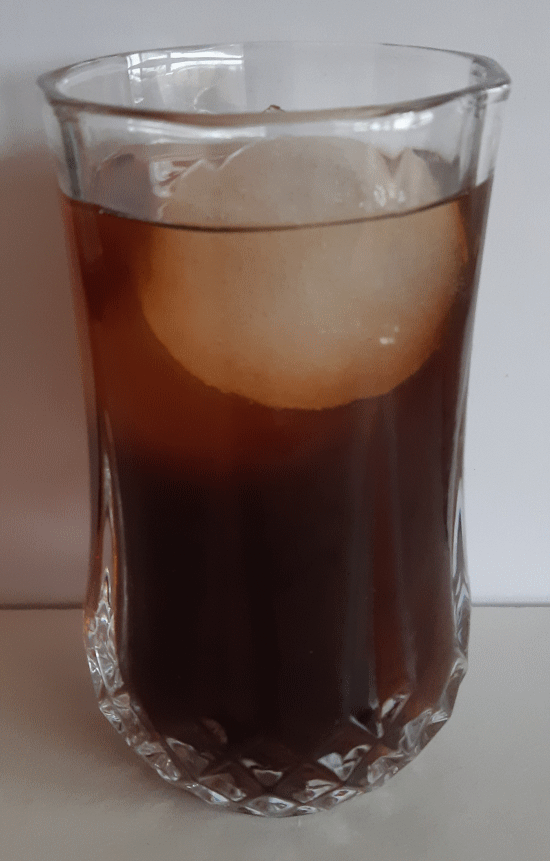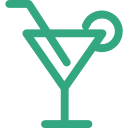With the warm weather we’re going to stay with some long cocktails today. First up is the Cuba Libre.
The Cuba Libre (literally “Free Cuba”) is a highball cocktail consisting of cola, rum, and in many recipes lime juice on ice. Traditionally, the cola ingredient is Coca-Cola (“Coke”) and the alcohol is a light rum such as Bacardi; however, the drink may be made with various types of rums and cola brands, and lime juice may or may not be included.
The cocktail originated in the early 20th century in Cuba, after the country won independence in the Spanish–American War. It subsequently became popular across Cuba, the United States, and other countries. Its simple recipe and inexpensive, ubiquitous ingredients have made it one of the world’s most-popular alcoholic drinks. Drink critics often consider the drink mediocre, but it has been noted for its historical significance.
The drink was created in Cuba in the early 1900s, but its exact origins are not certain. It became popular shortly after 1900, when bottled Coca-Cola was first imported into Cuba from the United States. Its origin is associated with the heavy U.S. presence in Cuba following the Spanish–American War of 1898; the drink’s traditional name, “Cuba libre” (Free Cuba), was the slogan of the Cuban independence movement. The Cuba libre is sometimes said to have been created during the Spanish–American War. However, this predates the first distribution of Coca-Cola to Cuba in 1900. A drink called a “Cuba libre” was indeed known in 1898, but this was a mix of water and brown sugar.
The drink became a staple in Cuba, catching on due to the pervasiveness of its ingredients. Havana was already known for its iced drinks in the 19th century, as it was one of the few warm-weather cities that had abundant stores of ice shipped down from colder regions. Bacardi and other Cuban rums also boomed after independence brought in large numbers of foreign tourists and investors, as well as new opportunities for exporting alcohol. Light rums such as Bacardi became favored for cocktails as they were considered to mix well. Coca-Cola had been a common mixer in the United States ever since it was first bottled in 1886, and it became a ubiquitous drink in many countries after it was first exported in 1900.
Rum and Coke quickly spread from Cuba to the United States. In the early 20th century the cocktail, like Coca-Cola itself, was most popular in the Southern United States. During the Prohibition era from 1922 to 1933, Coca-Cola became a favored mixer for disguising the taste of low-quality rums, as well as other liquors. In 1921 H. L. Mencken jokingly wrote of a South Carolina variant called the “jump stiddy”, which consisted of Coca-Cola mixed with denatured alcohol drained from automobile radiators. After Prohibition, rum and Coke became prevalent in the northern and western U.S. as well, and in both high-brow and low-brow circles.
Rum and Coke achieved a new level of popularity during World War II. Starting in 1940, the United States established a series of outposts in the British West Indies to defend against the German Navy. The American presence created cross-cultural demand, with American servicemen and the locals developing tastes for each other’s products. In particular, American military personnel took to Caribbean rum due to its inexpensiveness, while Coca-Cola became especially prevalent in the islands thanks to the company shipping it out with the military. Within the United States, imported rum became increasingly popular, as government quotas for industrial alcohol reduced the output of American distillers of domestic liquors.
In 1943, Lord Invader’s Calypso song “Rum and Coca-Cola” drew further attention to the drink in Trinidad. The song was an adaptation of Lionel Belasco’s 1904 composition “L’Année Passée” with new lyrics about American soldiers in Trinidad cavorting with local girls and drinking rum and Coke. Comedian Morey Amsterdam plagiarized “Rum and Coca-Cola” and licensed it to the Andrews Sisters as his own work. The Andrews Sisters’ version was a major hit in 1945 and further boosted the popularity of rum and Coke, especially in the military. Lord Invader and the owners of Belasco’s composition successfully sued Amsterdam for the song’s rights.
During the Cuban Revolution in 1959, Bacardi fled to Puerto Rico. The following year, the U.S. placed an embargo against Cuba which prohibited the importation of Cuban products, while Cuba likewise banned the importation of American products. With Cuban-made rum unavailable in the U.S. and Coca-Cola largely unavailable in Cuba, it became difficult to make a rum and Coke with its traditional ingredients in either country.
Rum and Coke – from Wikipedia, the free encyclopedia

The Cuba Libre ("Free Cuba"), is a highball cocktail consisting of cola, rum, and in many recipes lime juice on ice. Traditionally, the cola ingredient is Coca-Cola ("Coke") and the alcohol is a light rum such as Bacardi; however, the drink may be made with various types of rums and cola brands, and lime juice may or may not be included.
The cocktail originated in the early 20th century in Cuba, after the country won independence in the Spanish–American War. It subsequently became popular across Cuba, the United States, and other countries. Its simple recipe and inexpensive, ubiquitous ingredients have made it one of the world's most-popular alcoholic drinks. Drink critics often consider the drink mediocre, but it has been noted for its historical significance.
Fill a highball glass with ice.
Pour the white rum and lime juice over the ice.
Top off with the cola.
[cocktail-ingredients]
Ingredients
Directions
Fill a highball glass with ice.
Pour the white rum and lime juice over the ice.
Top off with the cola.
